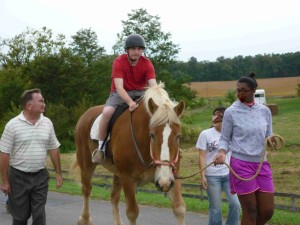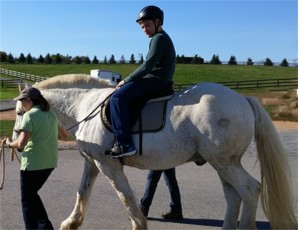 The problem
The problem
What do you do when a child with autism will not wear something that is required for safety?
This was the problem facing a therapeutic riding center with one client, an eight-year old boy with autism. The boy would not wear the safety helmet.
The rules are clear: no helmet, no horse.
Jon Luke, a determined volunteer at the center, tells how he asked for and found a solution. A boy, a horse, a happy ending. Watch this drama unfold!
The volunteer asked the TAGteach community for help
“I volunteer at an equine therapeutic riding center and am looking for some help with getting a young Hispanic boy with autism to wear a helmet. We need to have him wearing a helmet but he keeps pulling it off. Has anyone had a similar challenge and, if so, what did you do to successfully get the rider to wear the helmet?
The boy is eight years old, he may understand English, and he appears to know some basic sign language. We only get to work with him for one hour per week. We do what we can on the ground but try to get as much horse time in as possible, so we have been doing most of the helmet work while he is on the horse. We have limited space and use two side-walkers at all time for safety. The parents don’t speak much English so it is difficult to communicate to get them to practice at home, and they tend to undo the progress by forcing him to wear the helmet — which only gets him to pull it off faster.
We don’t think there is physical pain or discomfort as he does the same thing with just a lightweight ball cap, and we have had some short duration success with getting him to keep the cap on. So we think it is just the sensation of wearing something on his head that bothers him.
This is what’s been tried so far:
We have been trying to reinforce keeping the helmet on using goldfish crackers. This was mildly successful; we found skittles to be more motivating and were able to have him keep the helmet on for up to a count of 15. However, we felt that he was starting to learn to take the helmet off again for an opportunity to earn more Skittles. I’ve also been modeling wearing a helmet and putting the chin straps together.
We are going to try to teach him the tag (TAGteach) game. We have two girls who also ride at the center who know him. We plan to play the game with the girls to show him how the game works, and see if he can learn to tag me or the girls for wearing a helmet. Eventually we will reverse roles and tag him for wearing his helmet.
It’s been slow and there is some progress, but I’m looking to improve our effort or try something new, if others have had a similar experience. I’m ready to try a different approach.
I appreciate any input or resources anyone can provide.”
Suggestions poured in from experienced equestrian instructors:
To increase the boy’s duration of time wearing the helmet, an experienced instructor suggested:
For duration, you might try something like tagging when he passes markers in the arena. He may be able to comprehend this better than “leaving it on” for duration. So for example, every time he passes a fence post wearing the helmet, he gets tagged.
This instructor (Jane Jackson) explained further:
I use this a lot in riding lessons when things require duration and the kids do well with it. I just adapt the markers to the amount of distance the individual can handle. Sometimes I start with “3 steps” if I have to (wherever the learner can be successful). Then graduate to fence posts. Then graduate to dressage letter markers, (several fence posts), etc.
One week later — Woo hoo, a breakthrough!
“Thank you, everyone, for your ideas. We had a successful session with the eight year old autistic rider today. He rode the whole hour with the helmet on.”
It was a classic case of having a plan in mind, throwing it out the window (not totally), and adapting to the learner and the situation. It was also a perfect storm of teamwork. We had an excellent instructor (the owner of the riding center), great side and lead walkers (including one of Andre’s* favorite side-walkers who returned from a few weeks off), and a new caretaker who showed up with Andre’s mother. She was great, completely understood what we were trying to accomplish, and really helped to communicate with Andre. And of course we had skittles.
I started out with a little bit of success in tagging him for interacting with the helmet and putting it on. We had done some of this work before in previous sessions; now it became a bit of a game of taking it off and putting it on again to earn a Skittle.
After this, we decided to move to riding the horse. We put the helmet on and then quickly got him in the saddle. We got a couple of tags in but mostly the helmet came off right away. Each time we took him off the horse and started over. We managed to get him in the saddle with the helmet on just long enough to start walking the horse out from the loading deck. Again we got a few more tags but he pretty quickly would grab the straps to pull the helmet off.
Each time he pulled off the helmet we stopped, took him off the horse, walked him back to the loading deck, and started all over again. We got a couple of walk-outs and were able to tag him and give a skittle. On about the third or fourth time the magic happened! What was interesting is that before this session he did not seem that interested in being on the horse or riding. But on this repetition, when he took off his helmet and we stopped to take him off, he did not want to get off the horse. Bingo! Riding the horse just became the major motivator.
So we started all over again and this time he walked out even further. We tagged, celebrated with cheers and a skittle and kept moving. I ran ahead a couple of markers and had the walker lead him to me — we tagged, cheered and celebrated some more — and another skittle. Then it was almost like the light bulb turned on in his head — you could almost see it. The act of riding to catch up to me became a fun game and his face lit up with big smiles.
From that point on he just rode and seemed to completely ignore the helmet. I ran even further ahead so he would have to catch up to me on the other side of the arena. The instructor even had him chasing me in a trot, trying to catch me as if it were a race to the end of the arena. Big smiles and lots of joy.
The instructor switched to another activity, showing him how to get the horse to “walk on” by tapping the saddle horn. She also showed him the hand signal for stopping the horse. Then the game was to signal to walk the horse over to me, signal to stop and earn a skittle. If he missed the cue to stop, the walkers walked the horse past me. Andre had to walk the horse around again to try and stop next to me to earn a Skittle.
It all worked really well until we switched to goldfish crackers. They didn’t quite cut it as a motivator. So we switched strategies again, and got him motivated by giving him colored rings to hang on a T-bar. He would ride to me, signal stop to get the colored rings, and then ride over to the T-bar and put the rings on it. This turned out to be a good transition from candy and cracker rewards to a game reward.
This went so well that we decided to leave arena and go outside for a trail ride. By this time he was relaxed, riding great and smiling more than we have ever seen him smile before. Everyone was so proud of him. More cheers came from other staff, parents, volunteers, and riders as we passed by them to go to the trail. The combination of skittles, games and cheers really seemed to work and kept his mind off the helmet.
We ended the riding session back in the arena. We gathered on the mounting deck with some fellow riders, who all had their helmets on, and took a group photo.
It was a huge success. To top off this great ride we learned that it was Andre’s eighth birthday! What a day. It doesn’t get much better than this.”
Learn More
Read more about TAGteach for riding instruction
Here is a webinar snippet with video that shows how you can use TAGteach in riding lessons:
Click here to learn more about this webinar
*Child’s name changed to protect privacy
 What is TAGteach?
What is TAGteach?
TAGteach stands for Teaching with Acoustical Guidance. TAGteach is a teaching and communication method based on the scientific principles of Applied Behavior Analysis (ABA).
TAGteach enables extremely precise positive reinforcement of behavior by using an acoustical signal to “mark” the behavior – at the precise moment the child performs the behavior! The acoustical signal is a short, sharp sound made by a handheld device (the “tagger”). When the child performs the correct action, the parent/instructor immediately presses the button on the tagger and hands over a treat (candy, treat, token, praise, social recognition, or money) as a reinforcer.
With TAGteach, it is easy to reinforce behaviors precisely and quickly. The immediate, accurate feedback and positive reinforcement result in the child performing the correct action more often, and for longer periods of time. With immediate feedback and learning tasks broken down into small steps, children (and adults) can learn many new skills with TAGteach — at their own pace.
For more information visit the TAGteach website.
Join the free TAGteach Yahoo Group.
TAGteach taggers are available here.
See Martha’s book about TAGteach for Autism or feel free to ask me a question (with no obligation).
Sign up for my mailing list to receive updates, new articles and free tips right in your inbox!
If you liked this post, please share it. Thank you!
